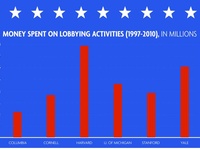But with ties to the American South and a knack for recognizing shared roots, Faust has grown more adept at winning the hearts and votes of both liberals and conservatives.
Earlier this year, Faust met with House Majority Leader Eric Cantor, a darling of the far right and an influential Republican. Cantor represents a wing of the Republican party that is largely opposed to the initiatives being promoted by Harvard in Washington—stem cell research, for example—but in their home state of Virginia, the two found a shared love.
Before he left the meeting, Cantor told Faust that she needed to travel to Washington more frequently to ensconce herself as the face of Harvard and dismantle the image of the old, white Harvard man in tweed.
“It’s always important to try to make a personal connection with someone and treat someone like an individual person and not come in and act as if they’re just a vote,” Faust said.
As a president that lacks the strong Washington ties of her predecessor Lawrence H. Summers, who was Secretary of the Treasury before assuming the Harvard presidency, Faust has had to make up ground to establish herself as a presence in the nation’s capital.
“Before I ever met her she seemed like an imposing woman. A great scholar,” said Executive Washington Editor for Bloomberg News Al R. Hunt, who hosted the reporter’s roundtable. “The one thing that we’ve benefited from is seeing what an interesting and down-to-earth person she is.”
WADING INTO WASHINGTON POLITICS
The Office of Government, Community, and Public Affairs was founded in 1970s during President Derek C. Bok’s tenure, although it went by a different name at the time, according to Casey, who has been in involved in Harvard’s lobbying efforts for 20 years.
“Derek was very farsighted, and I am sure he could see the growing importance of the federal government to the University,” said Nan F. Nixon, who was one of Harvard’s first chief lobbyists.
The need for a University lobbying office goes back to the historic expansion of the federal government that followed World War II with the passage of the GI Bill and the creation of Pell Grants. These acts funneled money from Washington D.C. to U.S. universities, encouraging Harvard and others to jockey for position at the Congressional cash spigot.
But at the outset of Harvard’s lobbying activities, it was a far cry from the its current sophisticated effort. When Nixon was first hired she worked out of her apartment in D.C. and commuted to Cambridge each week. Eventually Nixon opened the doors at the University’s first Washington, D.C. office and added an assistant to her team.
Harvard was one of the very first universities to open a D.C. office, though many other schools soon followed suit, Casey said. MIT, the University of Pennsylvania, the University of Chicago, and many other schools have all established a lobbying presence in D.C. In fact, the University of Michigan’s office is only a few floors up from Harvard’s.
Former MIT President Charles M. Vest—who is widely considered to have set the standard for university presidents’ active involvement in D.C.—said that he often encouraged other universities to focus the importance of funding for higher education and “not specifically on their universities.”
Many other schools, including Boston University and Tufts, hire lobbying firms to do most of the heavy-lifting in government relations. Harvard, however, maintains an internal team of lobbyists and only employs lobbying firms on occasion to work on specific issues, Casey said.
By having lobbyists who can call themselves a part of the Harvard community, administrators say that the University is better represented, allowing them to foster closer ties with lawmakers at the state and the federal level.
Read more in News
Serving the Community?













